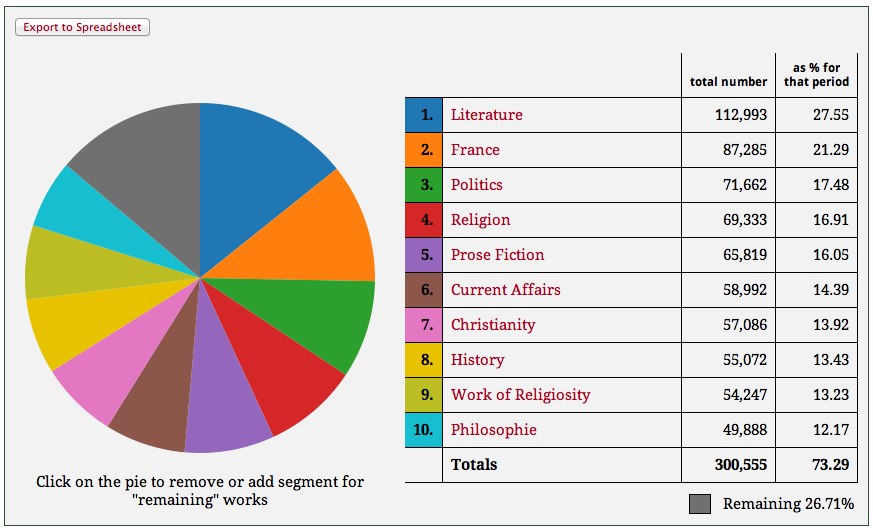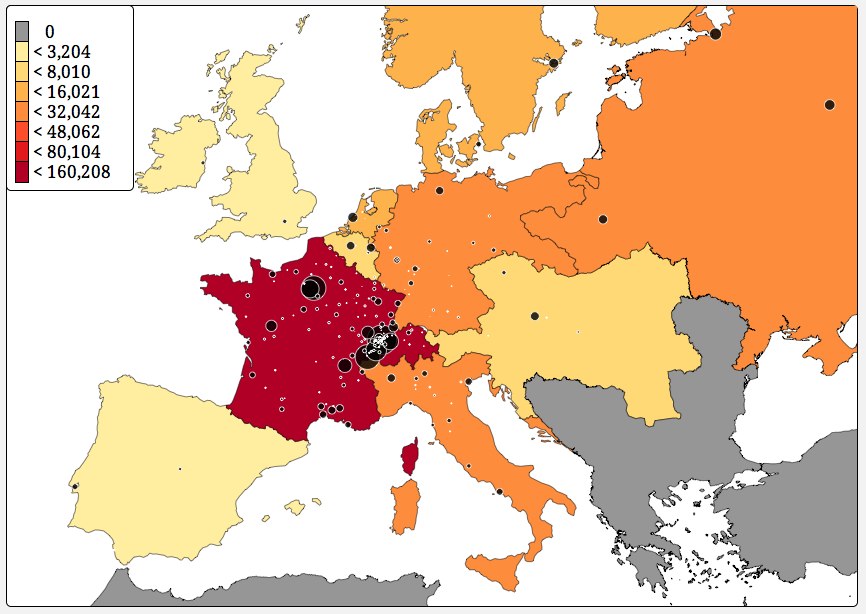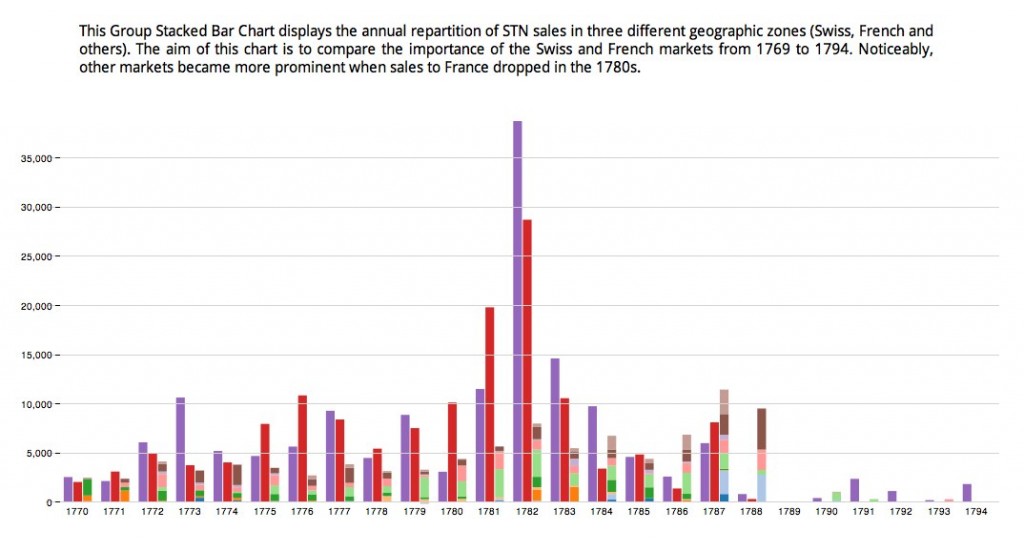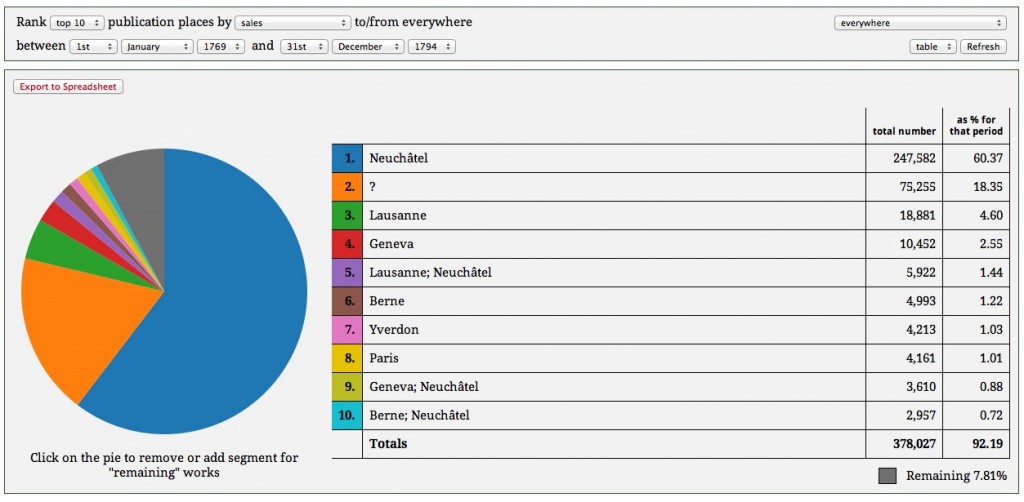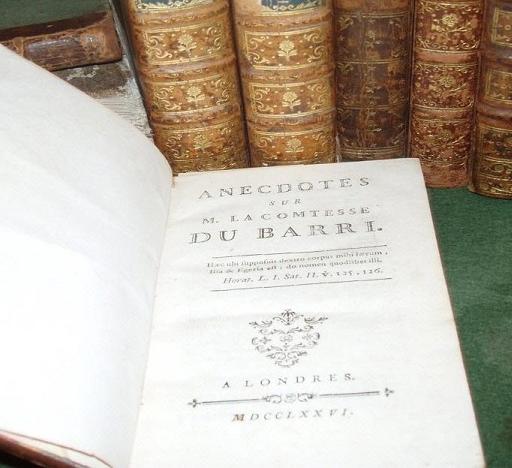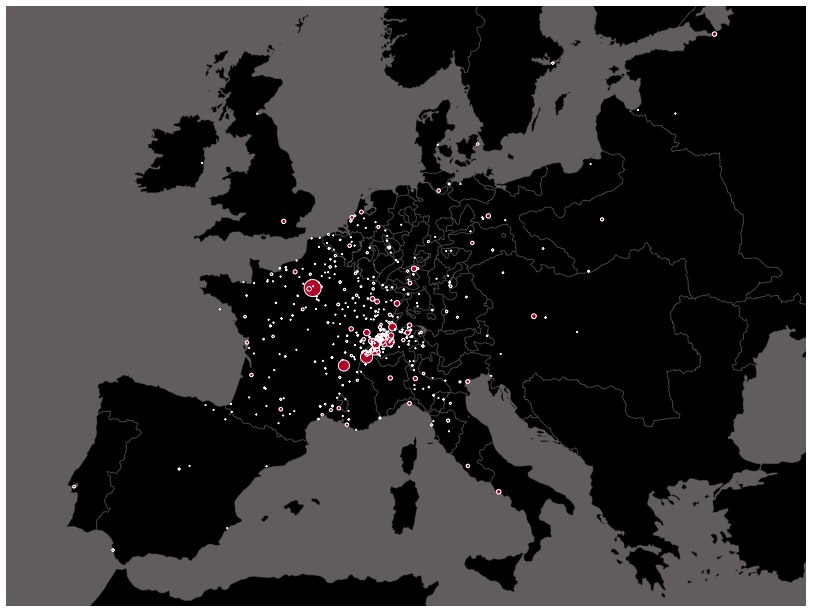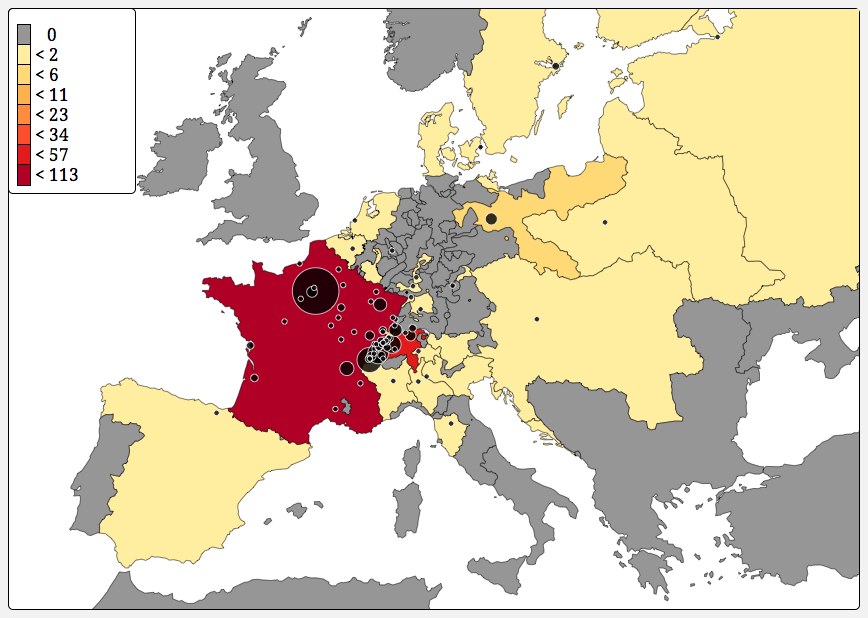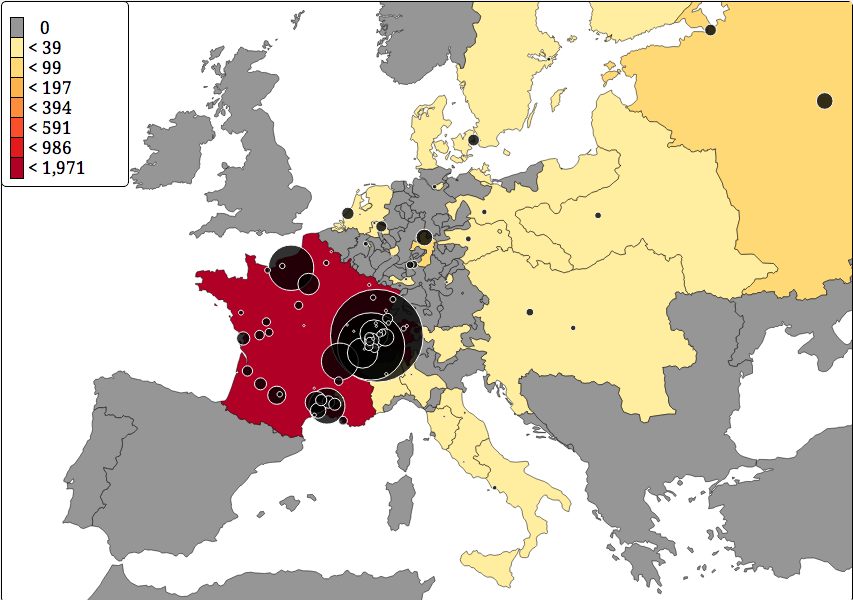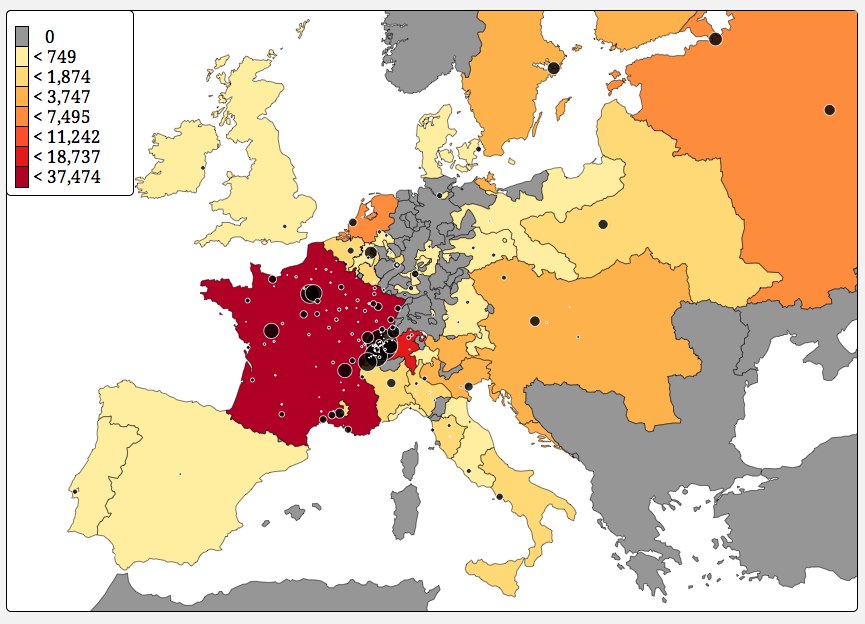How Swiss was the Société Typographique de Neuchâtel? A Digital Case Study of French Book Trade Networks
Simon Burrows and Mark Curran
Should the famous Société typographique de Neuchâtel (1769-1794) (STN) be viewed as a typical and representative ‘European’ publisher-bookseller, a ‘print shop across the border’ that offered the latest product of the mud-raking underground to the French market, or a provincial, peripheral, and Swiss-focused distraction? The question needs revisiting before we both trumpet the value of our recently published French Book Trade in Enlightenment Europe (FBTEE) database — which recreates the society’s entire knowable bookselling business — and assess its potential for substantially revising scholarly understanding of the eighteenth-century French book trade and, dare we dream, the enlightenment.[1]
Fortunately the database itself is ideally structured for providing powerful new geographically-based insights, since its fundamental purpose is to pinpoint and map transfers of books between the STN and its clients in time and space. In addition to offering carefully structured taxonomic and bibliographic data on books — capable of dealing with issues such as false imprints, original language of publication, and the legal status of editions — the database offers multiple forms of spatially related data. It records where clients were based, where books were published and from whence they were despatched to the STN, as well as the languages in which works were originally published. For purposes of analysis, it also groups geographic locations into provinces, countries, and wider regions, as well as into a variety of transnational entities (e.g. ecclesiastical lands; the Holy Roman Empire; university towns). Likewise it groups clients by the type of trade they conducted with the STN and their stated professions, as well as into wider economically and professionally-defined groupings.
By using the project’s on-line interface, it is thus possible to rank, compare, or map clients, books, authors, or places by volume of trade over time, using increments as small as a single day. This makes it possible to reveal instantly, in ways not feasible in pre-digital studies, both macro-sales trends or bestseller listings and more finely calibrated micro-histories of particular books, places, or clients. In order to understand how far the STN should be considered a distinctively Swiss venture, we will need to look at all three, using both macro- and micro-lenses.
Robert Darnton, of course, has already opined on the very same question in his seminal The Forbidden Bestsellers of Pre-Revolutionary France.[2] Employing an elegant argument that centred upon the idea that European printers located from Amsterdam to Geneva swapped substantial volumes of new works amongst themselves as soon as they were printed, Darnton constructed the STN as a representative business capable of supplying more-or-less anything.[3] The society’s sales patterns, it was suggested, differed little from those of other extra-territorial publishers selling clandestine works into France from warehouses in Switzerland, Holland, Belgium, Bouillon, or the German Rhineland. This thesis proved so persuasive that it has become the main prism through which the STN, and indeed the entire late ancien régime publishing trade, is generally understood.[4] Indeed, its stylish simplicity helped us to justify our own project to our Arts and Humanities Research Council (AHRC) funders: a database of a single publisher’s trade with wider representative value would allow scholars to expansively compare European reading tastes on the eve of the French Revolution. Who could resist green-lighting such a tantalising proposal?
Better understanding the more complex realities of the STN’s market orientation through the FBTEE database must begin with a widescreen view of the 400,000-plus books that the Neuchâtelois dispatched to clients across Europe. Ranking the broadest-available geographic entities in the interface (as on the map below or — for the interactive version — here) reveals that Helvetic traders — that is to say those based in the geographic region of Switzerland, including states that were outside the eighteenth century Swiss Confederation such as Geneva and Neuchâtel — were the biggest recipients of STN-traded books. They took 39% of the society’s unit stocks. French traders received a little under 37%. Wider European clients combined accounted for just over 24%. Caveats, as always, are necessary before making too much of these results. Many books were exchanged locally rather than ‘sold’; entire editions were regularly commissioned; newly printed works were dispatched to established clients speculatively; and a few copies went to censors, the authorities, or political allies. Moreover, countless works shipped to Geneva or Lausanne clearly went further afield. None the less, the sheer volume of data at least compellingly shows that the STN was much more than a simple ‘print shop’ across the French border.
Pinning down what sort of operation they were, however, is complicated by significant temporal fluctuations in the data. At the core of the FBTEE database sit over 70,000 ‘transaction’ or ‘event’ entries, that record day-and-date when the STN’s orders were sent and received (or, more accurately, when these events were accounted for). A calendar of the society’s entire trade can thus be recreated and is visualised here. Equally, we might try to examine the STN’s shipping records on a daily, weekly, monthly, or annual basis, for individual authors, places or, as in the example given here, particular titles. Our colleague Vincent Hiribarren’s interactive visualisation of trade on an annualised basis, found in our ‘visualisation gallery’ and below, most clearly shows how the society’s market orientation changed over time.[5]
Between 1770-1772, as the Neuchâtelois built up their business, their client base largely remained local or based along the most accessible communications routes along the Rhine and Rhone corridors. By the mid-1770s they had established extensive networks across Europe, but particularly in France, which remained their largest market until the early 1780s. This was also the period during which the STN’s trade was at its height (see graph below or its interactive version here). However, as Leeds PhD student Louise Seaward is currently establishing, from 1783 French measures aimed at stopping the illegal book trade added to the costs and risks of doing business in France.[6] Consequently, the French trade declined and the society began reorientating their trade towards Italy and Northern and Eastern Europe.
As their market orientation shifted in accordance with changing economic and regulatory sands, however, one important thing remained constant: the society predominantly sold Swiss books. 60% of unit shipments were of Neuchâtel editions, largely those from the society’s own presses. The majority of the remaining top twenty places from which the society sourced works were also Swiss. In total, over 75% of STN ‘sales’ (313,089 units) were for editions positively identified as having been published in Switzerland. By contrast, only one percent of unit sales appear to have involved Parisian editions; while just over half of one percent were from London (see the table and graph below or its interactive version here). Of course, some of the recorded imprints may have been false, although where possible this has been taken into account — this search runs on the imprint stated on the title page unless corrected by bibliographic information from library catalogues. But a bigger uncertainty comes from the fact that almost one-fifth of STN envois (76,544 units) relate to bibliographically unresolved works or those that carried no imprint at all. Many of these works were clandestine or illegal in some way; their publishers wishing to conceal or falsify their place of origin for marketing purposes or to protect their backs. How can we know where these came from?
A case-by-case analysis can be very revealing. It can, for example, help to expose the likely publishers of specific clandestine editions. Mathieu-François Pidansat de Mairobert’s underground scandalous biography of Louis XV’s final mistress, the Anecdotes sur Madame la Comtesse du Barry, was first published in 1775. The extraordinarily high numbers of this work that the STN received from François Grasset of Lausanne in 1776 and early 1777 suggest that he was the publisher of the 1776 Swiss edition. Further, the fact that the STN took a remarkable 825 copies from Grasset during this period suggests that, in an era when a normal print run was 500-1,000 copies, Grasset’s print run was perhaps a phenomenal 5,000 or more (for further details see here). Consumers could not resist political and sexual scandal.
But ploughing through nearly 4,000 distinct bibliographical entities whilst trying to keep the big picture in mind is an exhausting and impractical undertaking. As a consequence, the FBTEE database interface has been designed to make it easy to seek the origins of such works on a more general level. A number of filters have been incorporated that allow users to interrogate pre-determined subsets of the data. In all there are eight options menus (with summaries available here), that can be used to delicately but powerfully nuance global dataset queries. Searches can be restricted to works which were illegal or in translation; to female clients; to wholesale book dealers; or to data drawn from various types of sources. Most importantly for current purposes, we can limit queries to certain types of edition, as defined by publishing origins. If we select works whose place of publication is unknown, then rank the supply origins of such works by geographic zone as has been done here, we learn that at least 56% of such works were sent to the society from the Helvetic zone. From what we already know about the STN’s supply patterns, we can therefore confidently suggest that somewhere between 90% and 95% of the books that they traded were Swiss editions.
At this point, all hopes of seeing the STN as a representative European publisher-bookseller depend upon a simple question: to what extent did Swiss books mirror those printed elsewhere? The reconstruction of the STN’s intellectual milieu through an examination of their correspondence networks allows for some initial insight here. A cartographic visualisation of the locations of the STN’s correspondents (see below and here) shows, as we might expect, that clients were concentrated in Switzerland, Paris, frontier regions of France, and along the Rhine, Rhone, and other prominent river corridors in France, Germany, and Italy. However, the STN’s general correspondents were comprised of everyone from booksellers and publishers to Versailles politicians such as the comte de Vergennes, the French foreign minister who kept a watchful eye on the extra-territorial book trade. They include the chandlers, printfounders, inkmakers, and paper merchants who supplied printshop essentials, and business agents, postmasters, and wagoners who facilitated the movement of books around Europe.[7]
Once (as below and here) we restrict the focus of enquiry to ‘Men of Letters’ — the intellectuals and academics who supplied the society with fresh manuscripts to publish, or who wrote to Neuchâtel with the latest literary intelligence — a much more clustered grouping emerges. The vast majority of such individuals were based either in France — over two-thirds of them lived in Paris — or in geographic Switzerland. Again, some caution is necessary: the database counts the number of times that a professional designation is used, and since some individuals have more than one professional designation, a little double-counting is unavoidable. In the case of this search, thankfully, there is an overlap in only 5% of cases (for full data see here). Once again, the results are sufficiently overwhelming to engender confidence. With 112 and 95 correspondent designations respectively, France and Switzerland were home to 88% of the ‘Men of Letters’ who corresponded with the STN. Most of the 12% based elsewhere wrote from courtly capitals in Germany, Italy, and Northern Europe, from Stockholm, Warsaw, Vienna, St. Petersburg, and above all, with five designations (but only four correspondents), Berlin, home to the Prussian monarchs, who were then sovereign princes of Neuchâtel.
Thus, a preliminary sketch suggests that the STN’s intellectual world was more Franco-Swiss than the raw bibliometrics reveal. This impression is strengthened when we browse outlying centres such as Berlin to see who the ‘Men of Letters’ in residence there actually were. This query reveals them to have been the celebrated writer and bookseller Friedrich Nicolaï; the bestselling philosophe and slave trade abolitionist, the abbé Guillaume-François-Thomas Raynal; the well-known Italian mathematician and astronomer, Giovanni Francesco Mauro Melchiorre Salvemini di Castiglione (who was double-counted); and the physician Nicolas de Béguelin, who was a tutor to Frederick the Great and became Director of the Berlin Academy. Of these, Béguelin was Swiss, Raynal French, and Castiglione a long-term resident of Lausanne, where he embraced Calvinism and taught for 15 years.
This analysis can be pushed further by exploiting the FBTEE database’s keyword system for describing the content, genre, and ideological tendencies of books. Certainly there are areas where the Swiss Protestant ethos comes across strongly. Unsurprisingly, this is particularly true of the religious books the STN traded: the vast majority were either Protestant or generically Christian. When, as above, we map ‘Works of Religiosity’ (our term for works written with a clear Christian purpose), the Protestant arc is clearly visible, running from French-speaking Switzerland down to the Southern French strongholds such as Nîmes, then up through Montauban and Bordeaux to La Rochelle. The trend is clearer still if we map the dissemination of Bibles by the STN.
The religious works sold by the STN were clearly catering to its Protestant co-religionists. This view is also reinforced if we use the database to compare sales of books to the Protestant and Catholic clergy. The Protestants focused on religious texts for themselves and their flocks; the Catholics — who to be fair included many worldwise literary abbés — certainly did not. Perhaps more surprisingly, the scientific works traded by the STN appear to have been distinctively Swiss. Leaving aside textbooks, commissioned works, reference books, and works touching upon science incidentally, it is Swiss luminaries such as Charles Bonnet, Albrecht Haller, and Samuel Tissot who dominate their scientific bestseller list.
Yet, at this stage at least, it would be inappropriate to take the argument too far. The Swiss booksellers were significant cultural intermediaries, facilitators of significant cross-cultural transfer.[8] They published their own translated editions of foreign works, especially English and German literary works, and sold them across francophone Europe (see map below and here). In all, the STN sold 300 works translated from English or German, which accounted for almost 10% of total shipments (40,050 out of 411,000). Equally, the society sold the literature of travel and exploration in large quantities (23,975 units), in the process familiarising European readers with other European and world cultures. We might also note here the large numbers of works addressing historical themes, including textbooks, biographies, and enormous multi-volume national histories. Thus, while in some domains the stock of the STN seems to have been particularly Swiss in subject matter, in others it was extremely cosmopolitan. Moreover, as we first outlined in a lecture at the Library of Congress (available as a podcast here ), the STN seems to have sourced books on particular themes and in specific genres in broadly — and often remarkably — similar proportions from both within and without Switzerland. This suggests that Swiss preoccupations were very similar to those of other (francophone) Europeans. On the level of generic subject matter, if not specific orientation, the STN’s stock appears to have a wider representative value.
So to the question ‘how Swiss was the STN?’ this brief case study offers a rather complex answer. Certainly, any future treatment cannot ignore the fact that the STN’s stock was Swiss, and its market orientation was less towards France than has often been thought. Ideologically, religiously, politically, and, perhaps more surprisingly, scientifically it had strong Swiss biases, too. But at the same time, in many domains, the STN shared in and promoted the intellectual cosmopolitanism of the enlightenment and its common concerns. From a distinctly Swiss base, it was outward facing and firmly embedded in the literary culture of its day. The task of eliciting and explaining what this means for our understanding of the book trade in particular and the enlightenment in general must, however, be left to another day.[9]
Meanwhile, the further development of the project points us in multiple directions. The simplest means to expand our work would be to create databases of other comparable archives — e.g. the archives of the Luchtmann publishing company in Leiden or the registers of the Veuve Desaint in Paris, both of which are contemporaneous with the STN. This might give further insights into the distinctively Swiss qualities of the STN. More valuable to the wider scholarly community, however, are plans to adapt the data structures and data entry tools to facilitate projects drawing on other bibliometric sources to map and measure the dissemination and reception of texts. Libraries and archives are teeming with such sources, which include publishers records; catalogues of public and private libraries and book dealers; confiscation and publishing permission registers; contemporary book reviews; book advertisements; comments in private correspondence; indices of banned books, etc.
The FBTEE database already contains data drawn from several such sources, but to better integrate them, it needs to structure all the ‘events’ they record in a similar way to our book trade transactions. This would, in theory, make it possible to map, list, or interrogate all types of event at once, and to generate a unitary and rich statistical reception history of books, in much the same way as Amazon.com presents sales statistics and reviews on contemporary merchandise. It also offers the possibility of gathering more qualitative data, not dissimilar perhaps to that in the various national Reading Experience Databases.
Finally, our tools and approaches can be applied to projects focused on other times and places, although they are probably best suited to societies where access to print and print technologies were limited enough to make such research manageable. The cut off point in Western Europe or North America is thus the second printing revolution of the early to mid-nineteenth century; in colonial Australasia it is probably somewhat later; and in parts of Africa more recent still. The ultimate prize, then, is a unitary but flexible digital system for researching, accessing, and calibrating the dissemination and influence of ideas, knowledge, and culture across the entire print era. The FBTEE database is a small but foundational step in that direction. In this sense, at the very least, our single Swiss publisher’s archive has proved to have a more global representative value.
- [1]This article and the database on which it draws are outcomes of the Arts and Humanities Research Council-funded project on the French Book Trade in Enlightenment Europe, headed by Simon Burrows at the University of Leeds. The database is co-authored by Simon Burrows and Mark Curran, who wish to thank the AHRC, the University of Leeds and project team members Sarah Kattau, Amyas (Henry) Merivale, and Vincent Hiribarren for their support throughout the project.↩
- [2]Robert Darnton, The Forbidden Best-Sellers of Pre-Revolutionary France (London and New York: Norton, 1996). For his statistical appendices, which inspired the STN database, see Robert Darnton, The Corpus of Clandestine Literature in France, 1769-1789 (London and New York: Norton, 1995).↩
- [3]Darnton’s argument is deconstructed in Mark Curran, “Beyond the Forbidden Best-Sellers of Pre-Revolutionary France,” Historical Journal (forthcoming). A more extensive examination and re-evaluation of the book trade will appear in his monograph from this project (see note 9 below). For an overview of the STN’s illegal trade across Europe in the light of the database see Simon Burrows, “French Banned Books in International Perspective, 1770-1789” in Experiencing the French Revolution, ed. David Andress, forthcoming SVEC (Oxford: Voltaire Foundation, forthcoming).↩
- [4]Besides the works already noted, the major published studies of STN and its trade are L’Edition neuchâteloise au siècle des Lumières: la Société typographique de Neuchâtel (1769-1789), ed. Michel Schlup (Neuchâtel: B.P.U.N., 2002); Le Rayonnement d’une maison d’édition dans l’Europe des Lumières: la Société typographique de Neuchâtel 1769-1789, ed. Robert Darnton and Michel Schlup (Neuchâtel: B.P.U.N.; Hauterive: Editions Gilles Stinger, 2005); Jeffrey Freedman, Books Without Borders in Enlightenment Europe: French Cosmopolitanism and German Literary Markets (Philadelphia, PA: University of Pennsylvania Press, 2012).↩
- [5]It is appropriate here to acknowledge Vincent Hiribarren’s sterling work at developing maps and visualisations for the project, initially on a shoestring budget. All the visualisations from the project used in this paper are the result of his work. For more of Dr. Hiribarren’s work see http://www.vincenthiribarren.com/.↩
- [6]Louise Seaward is currently in the final year of her doctoral project on French policing of the extra-territorial book trade, and has worked closely with the project team.↩
- [7]A handlist of most of these people is available on-line here. It lists correspondents and their professions under a single place of residence / correspondence. The list has been used for previous explorations of the STN’s trade networks by Frédéric Inderwildi and Thierry Rigogne. See Frédéric Inderwildi, “Géographie des correspondants de libraires dans la deuxième moitié du 18e siècle: La Société typographique de Neuchâtel, Cramer et Gosse à Genève,” Dix-huitième siècle 40 (2008): 503-22 ; Thierry Rigogne, “Librarie et réseaux commerciaux du livre en France à la fin de l’Ancien Régime” in Le Rayonnement d’une maison d’édition, ed. Darnton and Schlup (Neuchâtel: Editions Gilles Attinger, 2005), 375-404.↩
- [8]For preliminary reflections on the STN’s role in cultural transfers see Mark Curran, “The Société typographique de Neuchâtel and networks of trade and translation in eighteenth-century francophone Europe” in Cultural Transfers: France and Britain in the Long Eighteenth Century, ed. Ann Thomson, Simon Burrows, and Edmond Dziembowski, SVEC 2010:04 (Oxford: Voltaire Foundation, 2010), 257-67.↩
- [9]This task will be undertaken in the two interpretative monographs stemming from the project, which will be published by Continuum in 2013. The French Book Trade in Enlightenment Europe, Volume 1 will be Mark Curran’s study of the STN as a publisher, entitled Selling Enlightenment. Volume 2 will be Simon Burrows’ study of the dissemination of enlightenment ideas and discourses, and is entitled Enlightenment Bestsellers.↩

